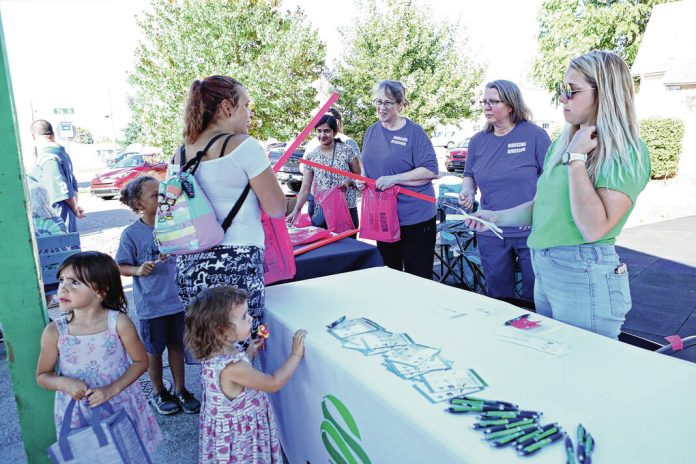
Carla Clark | For The Republic Aparna Antharaman, clockwise at right, Tracy Day, R.N., Amanda Organist, all with Bartholomew County Health Department, hand out yardsticks and information and Courtney Foust with San Souci, gives vouchers for clothing and free new socks and underwear during Columbus Robotics at Back to School Park Palooza held at 9th Street Park, Wednesday, August 31, 2022.
Bartholomew County is poised to receive nearly $1 million in additional public health funding next year through a statewide initiative that state officials say will “transform public health” in Indiana, which lags behind much of the country in public health outcomes.
The initiative, called Health First Indiana, was created through legislation passed this past legislative session and seeks to overhaul public health funding in a state that has long spent far less than most others on public health efforts, according to state officials.
In 2019, per-person public health spending in Indiana was $55, compared to $91 per person nationally, according to a recent analysis by the Governor’s Public Health Commission. In Bartholomew County, public health spending was less than $20 per person that year, the analysis states.
The new initiative is backed by $75 million budgeted for public health funding this fiscal year and $150 million next year — up from $6.7 million to $6.9 million per year in direct funding for local health departments since 2000.
“Communities across the state are recognizing this 1,500% increased state investment as a game-changer for Hoosiers not just today, but for generations to come,” Gov. Eric Holcomb said in a statement earlier this week.
A total of 86 of Indiana’s 92 counties have opted to participate in the initiative. The six counties that didn’t opt in — Whitley, Wells, Fountain, Johnson, Crawford and Harrison — can still participate in the 2025 cohort, state officials told the Indiana Capital Chronicle.
Johnson County officials told the Daily Journal in Franklin that their local health department doesn’t need the extra cash right now, nor the strings attached to it.
This was a collective decision made by the Johnson County Board of Commissioners and Johnson County Health Department officials. “Our health department is already running 95% of what is required within this new bill,” Johnson County Commissioner Kevin Walls said. “So that’s one of the reasons we dropped out.”
Local funding
As part of the initiative, Bartholomew County will receive $988,011 in 2024, according to the Indiana Department of Health. The county also is eligible for $1.78 million to $2.38 million in funding in 2025 should county officials decide to participate again.
To get the money, county officials had to agree to provide certain core services, many of which the local health department already provides. Some of the services include trauma and injury prevention, chronic disease prevention, maternal and child health, among several others.
The money will be spread across the Bartholomew County Health Department’s divisions, officials said.
The nursing division anticipates using the funds to focus on tobacco prevention and cessation efforts, chronic disease prevention, trauma and injury prevention, tuberculosis prevention, immunizations, maternal and child health, infectious disease surveillance, among other services, said Amanda Organist, the division’s director.
“We are fortunate that we have been able to provide services/activities in most of the core services,” Organist said. “We will be working on enhancing the services available at the health department to the community. We will also be working on collaborating with many community partners to make sure individuals know what services are offered and where the services are available.”
The department’s Environmental Health Division hopes to use the funds to focus on minimum housing inspections, full onsite wastewater system inspections for property transfers, assessments for childhood blood lead contamination, among other efforts, according to the division’s organizational 2023 planning document.
“We definitely see it as an opportunity to expand our services, to help a lot of different community members which may or may not have been helped (before) and join with … community partnerships,” said Link Fulp, the department’s director of environmental health. “…That will give us an opportunity to do that.”
While the new initiative aims to bolster the budgets of local health departments, it remains unclear the extent to which the program will increase local public health spending.
The Bartholomew County Council, which has the final say on the local health department’s budget, is expected to hold its first vote on next year’s budget on Tuesday, which includes considering the budget for the county health department.
Health outcomes
The push to boost public health funding in the state comes as Indiana continues to lag behind much of the country in public health outcomes.
In 2021, 33% of U.S. adults were obese, 11.5% were smokers and infant mortality was 5.5 deaths per 1,000 live births from 2017 to 2021, according to the Centers for Disease Control and Prevention.
In Indiana, 36% of adults were obese, 21% were smokers and infant mortality was about 6.8 deaths per 1,000 live births over the same period, one of the highest rates in the nation in 2020, according to the CDC.
In Bartholomew County, the obesity rate was 39%, according to Healthy Community’s 2021 Community Health Needs Assessment.
The Indiana Department of Health says that the smoking rate in the county was 21.5%, though Health Communities’ assessment found that about 15% of adults in Columbus Regional Health’s service area smoke.
The local infant mortality rate was 6.79 deaths per 1,000 live births from 2017 to 2021, according to state records.




